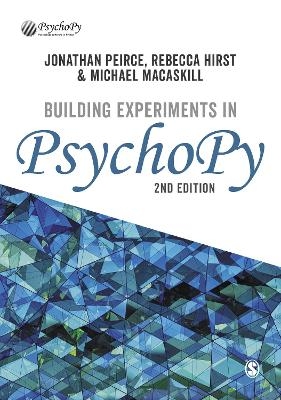
Building Experiments in PsychoPy
SAGE Publications Ltd (Verlag)
978-1-5297-4165-0 (ISBN)
PsychoPy is an open-source software package for creating rich, dynamic experiments in psychology, neuroscience and linguistics. Written by its creator, this book walks you through the steps of building experiments in PsychoPy, from using images to discovering lesser-known features, and from analysing data to debugging your experiment.
Divided into three parts and with unique extension exercises to guide you at whatever level you are at, this textbook is the perfect tool for teaching practical undergraduate classes on research methods, as well as acting as a comprehensive reference text for the professional scientist.
Essential reading for anyone using PsychoPy software, the second edition has been fully updated and includes multiple new chapters about features included in recent versions of PsychoPy, including running studies online and collecting survey data.
Part I teaches you all the basic skills you need (and some more advanced tips along the way) to design experiments in behavioral sciences. Each chapter introduces anew concept but will offer a series of working experiments that you can build on.
Part II presents more details important for professional scientists intending to use PsychoPy for published research. This part is recommended reading for science professionals in any discipline.
Part III covers a range of specialist topics, such as those doing fMRI research, or those studying visual perception.
"This book fills an incredibly important gap in the field. Many users of PsychoPy will be excited to learn that there is now a highly accessible and well-designed written guide to refine their skills." – Susanne Quadflieg, University of Bristol
Jonathan Peirce is Associate Professor in Psychology at the University of Nottingham, with a background in visual neuroscience and a particular interest in research methods. For his research, Jon needed precise (and dynamic) stimulus presentations. For teaching psychology undergraduates about research methods, he needed software that was intuitive enough for them to understand. The combination of these needs (and his generally geekiness) caused Jon gradually to create PsychoPy. Happily, many people have got on board with the project and it grew. When he isn’t designing experiments, writing software or trying to teach students to be awesome scientists, Jon can be found walking his dog, playing with his daughter or making unpleasant noises on a guitar. Michael MacAskill is a Senior Research Fellow in the Department of Medicine at the University of Otago, Christchurch. He is also the Research Director at the New Zealand Brain Research Institute. His training is in experimental psychology and his research is mainly in the field of Parkinson’s disease, through projects in brain imaging, neuropsychology, and epidemiology. His main joy, however, lies in measuring fast eye movements (saccades).Looking for better ways to study them, in 2008 he discovered what Jon had achieved with PsychoPy, and has since become a passionate believer in the enabling power of open-source software.Living in a geologically active area, Michael recently decided to move from a house perched on a cliff in a volcano to one situated in a very large lawn. In the weekends, he can be found mowing that lawn.
Chapter 1: Introduction
PART I: FOR THE BEGINNER
Chapter 2: Building your first experiment
Chapter 3: Using images: A study into face perception
Chapter 4: Timing and brief stimuli: Posner cueing
Chapter 5: Running studies online
Chapter 6: Creating dynamic stimuli (revealing text and moving stimuli)
Chapter 7: Providing feedback: Simple code components
Chapter 8: Collecting survey data using forms
Chapter 9: Using sliders
Chapter 10: Randomizing and counterbalancing blocks of trials: A bilingual Stroop task
Chapter 11: Using the mouse for input: Creating a visual search task
PART II: FOR THE PROFESSIONAL
Chapter 12: Implementing research designs with randomization
Chapter 13: Coordinates and color spaces
Chapter 14: Understanding your computer timing issues
Chapter 15: Monitors and monitor center
Chapter 16: Debugging your experiment
Chapter 17: Pro tips, tricks, and lesser-known features
PART III: FOR THE SPECIALIST
Chapter 18: Psychophysics, stimuli and staircases
Chapter 19: Building an FMRI study
Chapter 20: Building an EEG study
Chapter 21: Add eye tracking to your experiment
Appendices
| Erscheinungsdatum | 07.02.2022 |
|---|---|
| Verlagsort | London |
| Sprache | englisch |
| Maße | 170 x 242 mm |
| Gewicht | 570 g |
| Themenwelt | Geisteswissenschaften ► Psychologie ► Test in der Psychologie |
| ISBN-10 | 1-5297-4165-3 / 1529741653 |
| ISBN-13 | 978-1-5297-4165-0 / 9781529741650 |
| Zustand | Neuware |
| Haben Sie eine Frage zum Produkt? |
aus dem Bereich


